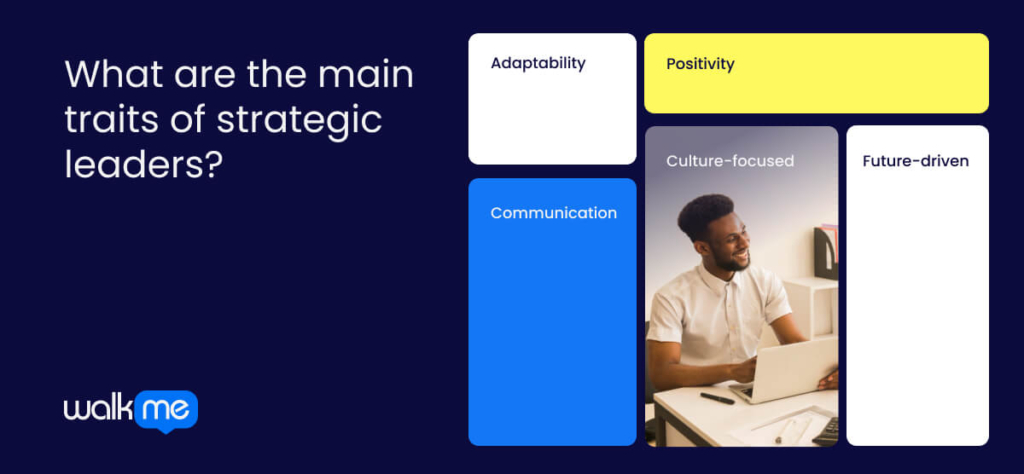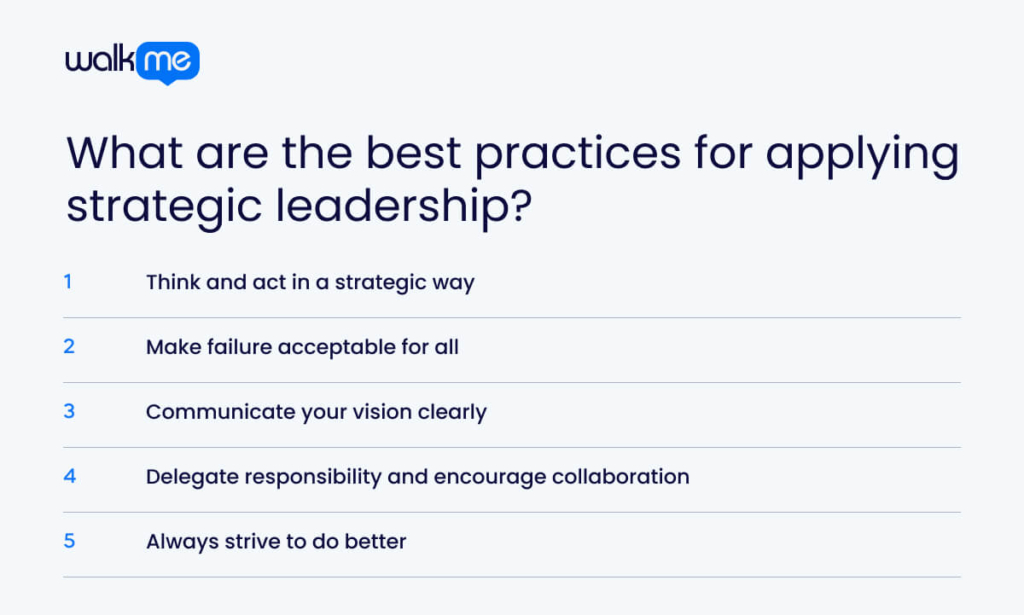Not having a clear strategy can cause a gap between what a company wants and achieves. In today’s fast-changing world, adaptability is key. Leaders must guide teams, handle change, find new opportunities, and execute plans well, no matter how the business world changes.
Strategic leadership uses different management styles to create a vision that keeps the company competitive in a changing, technology-driven world. These leaders inspire employees with a clear direction and help them work together to implement change.
Strategic leadership isn’t one style. It’s a mix of approaches focused on long-term goals. While some leaders focus on daily tasks, strategic leaders look at the big picture and how to best use talent to reach goals.
This article will explain what strategic leadership is, its key traits, how it differs from other styles, and give examples of strategic leaders, best practices, and the pros and cons of this approach.
What is strategic leadership?
Strategic leadership is when leaders use different styles to create a vision that keeps their company competitive. They adapt their approach based on the situation and guide employees through changes, inspiring teamwork and innovation.
For example, they might use democratic leadership for collaborative goals or servant leadership to meet employee needs.
The main objectives are to improve processes, boost productivity, and encourage new ideas, creating a workplace where employees can work independently, share ideas, and stay motivated.
How is strategic leadership different from other leadership styles?
Strategic leaders set the direction and goals for their organization. They create long-term strategies and, like transformational leaders, build a culture that promotes growth and innovation. It’s important to understand their organization’s strengths and the outside environment.
Here’s how it differs from other leadership styles:
Tactical leadership
Tactical leadership focuses on short-term tasks and goals, not long-term plans. They use rewards and punishments based on performance and rules. This approach works well for reaching short-term goals but doesn’t focus on growth or innovation.
Operational leadership
Operational leaders also focus on the short term, but their main job is managing daily operations. Unlike strategic leaders, who set long-term goals, operational leaders ensure everything runs smoothly day to day. They focus on efficiency and keeping the organization functioning well.
What are the main traits of strategic leaders?

The main characteristics of strategic leaders are:
Adaptability
Successful strategic leaders are adaptable and flexible. They adjust their plans and use new ideas to respond to changing conditions and market shifts.
This flexibility helps them pivot when needed, keeping the organization strong and able to handle obstacles and challenges. Adaptable leaders also seek out different viewpoints.
Simple problems are often solved quickly. But tougher problems need new ways of thinking, which come from diverse teams. Different perspectives, based on various backgrounds and experiences, help find solutions to complex issues.
Positivity
A positive attitude spreads easily. When your team is led by happy and positive people, they work harder and feel happier. Positivity can show up in many ways at work. For example, you can provide healthy snacks in the kitchen or have a pizza lunch once a month.
Balance fun and work. Strive to create a supportive, positive environment during the day.
Some leaders focus only on problems during strategy meetings. While it’s important to know about issues, you should also highlight what’s going well with your strategy. Celebrate your successes.
Communication
Leaders who think strategically communicate clearly so others can understand them easily. They also have strong listening skills, which is a second key trait. Good communicators listen carefully to understand team members’ concerns and address those concerns to gain their support.
They also know how their words, actions, and moods impact their team, and they adjust their communication and behavior to fit the situation.
Because they listen well and show empathy, they can motivate their team effectively. Engaged employees are likelier to do good work, overcome challenges, innovate, and help with the overall strategy.
Culture-focused
Strategic leaders focus on building a positive company culture. They know that a strong culture benefits workers more than micromanaging.
A healthy culture makes employees more engaged, motivated, and productive.
These leaders invest in culture because they believe it leads to long-term success. When employees are happy and aligned with company values, performance improves. Over time, a strong culture can have a bigger impact on success than other strategies.
Future-driven
Strategic leaders predict and prepare for market changes to stay ahead. They watch their industry, track trends, and keep their company relevant. They plan for both short-term results and long-term goals.
Not all leadership needs to focus on the future. Good operational leaders handle daily tasks well and work with people to meet short-term goals.
What are some examples of strategic leaders?
Here are some examples of individuals who have used strategic leadership well:
Steve Jobs
Steve Jobs’ vision and strategy helped make Apple a leader in technology. He focused on great customer service, ease of use, and simplicity, which made Apple stand out from its competitors.
In 1996, Jobs returned to Apple after being away for 11 years. He changed the strategy to focus on improving the consumer experience and innovating products. In the next 10 years, Apple introduced the iPod, iTunes, the iPad, and the iPhone. These innovations turned Apple from a struggling company into a tech leader.
Satya Nadella
When Nadella became CEO in 2014, Microsoft had problems like stagnation and internal conflict. He changed Microsoft’s focus from just software to being cloud-first. He encouraged a culture of learning, curiosity, empathy, collaboration, and growth.
Under his leadership, Azure, Microsoft’s cloud platform, grew and competed well with Amazon Web Services (AWS). Nadella promoted teamwork and innovation, breaking down company barriers. He showed leaders should keep learning, be open to feedback, and handle failures well. His example set a positive tone for the company.
This culture shift has helped Microsoft grow and adapt. By focusing on AI and digital transformation, Nadella has kept Microsoft at the forefront of technology, ensuring its future success and competitive edge.
Jeff Bezos
Amazon’s founder and former CEO is a great example of big-picture thinking leading to success. He started the company in 1994 after learning that internet usage grew yearly. This was even though the World Wide Web was still in its initial stages. Bezos saw this growth as a chance for a successful e-commerce platform in the long run.
He was right. Under his leadership, Amazon’s stock increased, and the company became a major player in e-commerce. Four years later, it was the biggest online sales platform. Over the past 20 years, Amazon has grown from an online bookstore into a huge company interested in e-commerce, digital streaming, artificial intelligence, and more.
What are the best practices for applying strategic leadership?

When applying strategic leadership in the workplace, keep these best practices in mind:
Think and act in a strategic way
Start by understanding how your organization interacts with its environment. Use this knowledge to make decisions for long-term success. Instead of solving problems alone, strategic leaders bring in internal and external experts. They value new ideas and test different approaches, not just what has worked before.
Strategic leaders plan for various scenarios and learn about future trends. They are always learning and welcoming new ideas and discussions. They know that standing still can lead to falling behind.
Thinking about the big picture helps you quickly see the scope of an issue. It lets you plan what will work and guess what might not. This broad view improves your strategic thinking and helps you prepare for possible scenarios in a project. A big-picture thinker can prioritize better, act faster, and guide a team through uncertainty.
Leaders focused on strategy act quickly, even in uncertain situations. They don’t spend too much time planning while opportunities pass by. They continuously learn, adapt, and re-strategize based on what works and doesn’t.
Make failure acceptable for all
Accepting failure and admitting it early is important for a company. This should be part of how you review and promote employees. Strategic leaders need to learn from failures, not just successes. They should recognize how some failures can lead to future success. They must also handle uncertainty and bounce back from failures to try new things.
Communicate your vision clearly
Communication is crucial for effective strategic leadership. To get team support, clearly share your vision and plan. Explain each person’s role so they understand their place in the bigger picture.
To improve communication, listen to understand, not just to reply:
- Pause before speaking to collect your thoughts.
- Be brief and direct.
- Explain why you need help when asking for it.
- Choose the best communication method, like a call instead of an email.
- Take notes in meetings and share a summary with clear steps and roles.
- Use friendly body language and make eye contact.
Good communication helps you share your vision and motivate others. Strategic leaders act as coaches and mentors. They explain the organization’s strategy and why some plans might work better. Keeping everyone engaged and aware of their role is key to executing the strategy.
Delegate responsibility and encourage collaboration
Strategic leadership also involves giving team members more freedom. This helps team members grow their leadership skills. Good leaders share responsibility, allowing employees to take calculated risks when making decisions.
This builds self-confidence and sharpens their skills. It also helps the organization succeed in the long run by teaching people to adapt and make decisions based on each unique situation.
Delegating tasks can lead to more teamwork. Employees get the chance to work with others across the organization. This helps them understand how different parts of the company work together. Instead of staying isolated, they learn to see the value in what everyone contributes.
Always strive to do better
Strategic leaders always aim to improve. They look for ways to improve work by reviewing data, talking with coworkers, and measuring progress toward goals.
They know no method is perfect, and there’s always room for improvement. Some team members may need more support or resources, while others prefer more independence. Leaders review current strategies and refine them to avoid wasting time and effort.
Strategic leaders never settle. They keep developing their skills and knowledge throughout their lives. They do this by meeting other leaders to learn from their experiences or mentoring others. Mentoring allows them to share what they’ve learned and continue growing.
What are the benefits of strategic leadership?
The main benefits of strategic leadership are:
Creates a better workplace culture
Strategic leadership creates an inclusive and welcoming environment where diversity and teamwork can thrive. It shifts the organization’s vision, values, and culture to align with its goals. This leadership style encourages a culture of innovation, pushing employees to think creatively and explore new ideas.
Companies with strategic leadership adapt more quickly to changes in the industry, regulations, and the market. This helps them stay strong in a changing business world. Team members in this environment often have better attitudes about their jobs.
A positive team environment can make employees feel they belong and are committed. This environment can lead to high-quality work, greater productivity, and lower turnover and absence rates.
Improved planning and innovation
A strategic leader can help their team improve planning skills. This boosts efficiency and performance. They guide the team in setting goals that are realistic and achievable. This approach leads to better results. For example, a team will be less resistant to change if a leader presents them with a roadmap for implementation.
Strategic leadership can also increase a team’s innovation. It does this by encouraging new ideas and creativity. This style creates an environment that supports coming up with new ideas. It also helps in solving problems quickly.
What are the challenges of implementing strategic leadership?
The main challenges of strategic leadership are:
Staying focused on a plan in the long-term
Predicting the future is hard. Sometimes, things happen that leaders don’t expect. Strategic leaders try to balance the present and the future. But the future can be unpredictable.
One of the biggest challenges of strategic leadership is staying focused on the long term. Leaders may get caught up in short-term results, like the next quarter’s profits. This focus can hurt the company later.
For example, if leaders focus too much on short-term profits, they might skip investing in long-term projects. These projects are often key to the company’s success.
To avoid this, leaders should have a strategic plan. It’s also important to have regular talks about the company’s long-term vision. These talks should show how short-term choices will help in the future.
Can lead to micromanagement or abuse
Strategic leaders often focus too much on the big picture. They might miss problems that are happening right now. This can push employees to work on tasks that seem important for the future while ignoring urgent issues.
The desire to see plans succeed can make leaders start micromanaging their teams. It can also result in an abusive work environment where you force employees to work on tasks they do not like doing.
To prevent this from happening, hold regular meetings with employees for feedback. This will allow them to have their say in their tasks and roles.
Use a strategic leadership approach to remain competitive in an ever-changing world
Strategic leadership guides an organization toward success by managing ongoing change and enhancing people and processes. Leaders must maintain a clear sense of direction while encouraging their teams to take ownership of goals. Balancing analytical skills for process development with the human aspect of building motivated teams is essential for success.
When the balance between focusing on processes and people is off, leadership often fails. Overemphasis on tasks without considering employee morale can lead to unmotivated employees. On the other hand, focusing solely on the human side may make work feel aimless.
Effective leaders understand that leadership is about working with people. They seek advice from experienced leaders, give their team decision-making freedom, and gather input from everyone. Clear task definitions and celebrating successes help maintain motivation and productivity.
FAQs
A strategic leader has skills in problem-solving, adaptability, communication, empathy, self-awareness, negotiation, teamwork, creativity, and trustworthiness.
You can develop strategic leadership skills by developing a strategic mindset, learning from other leaders, seeking employee feedback, building relationships, and embracing growth opportunities.

